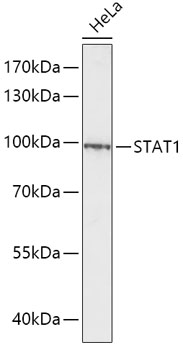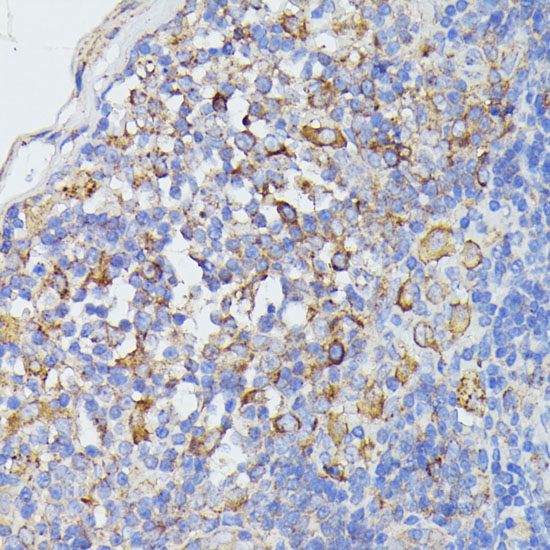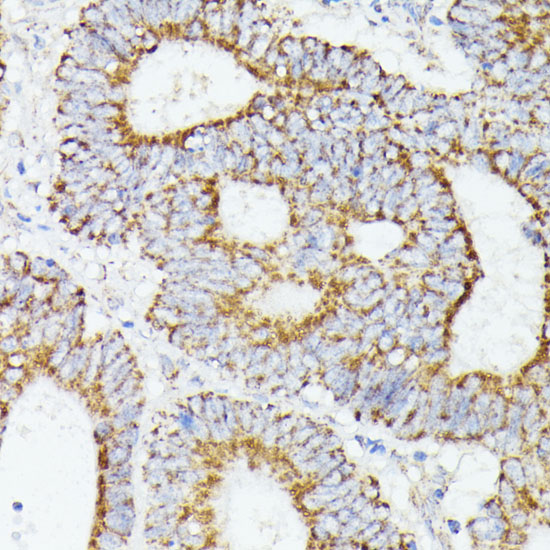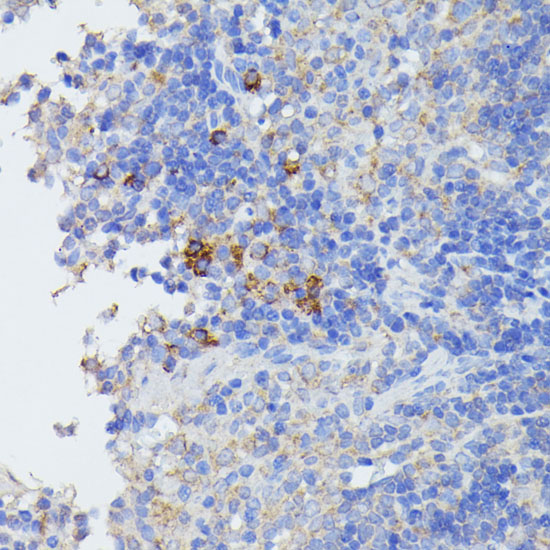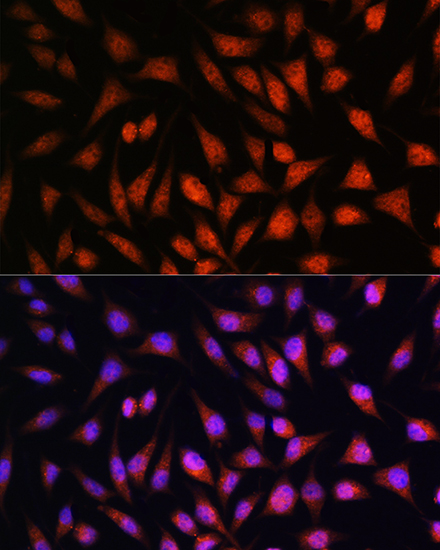Immunology Antibodies 1
Anti-STAT1 Antibody (CAB12075)
- SKU:
- CAB12075
- Product Type:
- Antibody
- Reactivity:
- Human
- Reactivity:
- Mouse
- Reactivity:
- Rat
- Host Species:
- Rabbit
- Isotype:
- IgG
- Antibody Type:
- Polyclonal Antibody
- Research Area:
- Immunology
Description
| Antibody Name: | Anti-STAT1 Antibody |
| Antibody SKU: | CAB12075 |
| Antibody Size: | 20uL, 50uL, 100uL |
| Application: | WB IHC IF IP |
| Reactivity: | Human, Mouse, Rat |
| Host Species: | Rabbit |
| Immunogen: | A synthetic peptide corresponding to a sequence within amino acids 650-750 of human STAT1 (NP_009330.1). |
| Application: | WB IHC IF IP |
| Recommended Dilution: | WB 1:500 - 1:2000 IHC 1:50 - 1:200 IF 1:50 - 1:200 IP 1:20 - 1:50 |
| Reactivity: | Human, Mouse, Rat |
| Positive Samples: | HeLa |
| Immunogen: | A synthetic peptide corresponding to a sequence within amino acids 650-750 of human STAT1 (NP_009330.1). |
| Purification Method: | Affinity purification |
| Storage Buffer: | Store at -20'C. Avoid freeze / thaw cycles. Buffer: PBS with 0.02% sodium azide, 50% glycerol, pH7.3. |
| Isotype: | IgG |
| Sequence: | NYKV MAAE NIPE NPLK YLYP NIDK DHAF GKYY SRPK EAPE PMEL DGPK GTGY IKTE LISV SEVH PSRL QTTD NLLP MSPE EFDE VSRI VGSV EFDS MMNT V |
| Gene ID: | 6772 |
| Uniprot: | P42224 |
| Cellular Location: | Cytoplasm, Nucleus |
| Calculated MW: | 83kDa/87kDa |
| Observed MW: | 91kDa |
| Synonyms: | CANDF7, IMD31A, IMD31B, IMD31C, ISGF-3, STAT91, STAT1 alpha, STAT1 |
| Background: | The protein encoded by this gene is a member of the STAT protein family. In response to cytokines and growth factors, STAT family members are phosphorylated by the receptor associated kinases, and then form homo- or heterodimers that translocate to the cell nucleus where they act as transcription activators. This protein can be activated by various ligands including interferon-alpha, interferon-gamma, EGF, PDGF and IL6. This protein mediates the expression of a variety of genes, which is thought to be important for cell viability in response to different cell stimuli and pathogens. Two alternatively spliced transcript variants encoding distinct isoforms have been described. |
| UniProt Protein Function: | STAT1: transcription factor of the STAT family. Phosphorylated and activated by receptor-associated kinases downstream of certain receptor tyrosine kinases, GPCRs, and receptors for various interleukins and interferons. Forms homo- or heterodimers that translocate into the nucleus where they regulate transcription. Two alternatively spliced isoforms have been described. |
| UniProt Protein Details: | Protein type:DNA-binding; Transcription factor Chromosomal Location of Human Ortholog: 2q32.2 Cellular Component: axon; cytoplasm; cytosol; dendrite; nuclear chromatin; nucleolus; nucleoplasm; nucleus; perinuclear region of cytoplasm Molecular Function:double-stranded DNA binding; enzyme binding; identical protein binding; protein binding; protein homodimerization activity; signal transducer activity; transcription factor activity; tumor necrosis factor receptor binding Biological Process: apoptosis; blood circulation; defense response to virus; endothelial cell migration; JAK-STAT cascade; negative regulation of angiogenesis; negative regulation of endothelial cell proliferation; negative regulation of I-kappaB kinase/NF-kappaB cascade; negative regulation of transcription from RNA polymerase II promoter; negative regulation of viral protein levels in host cell; positive regulation of mesenchymal cell proliferation; positive regulation of smooth muscle cell proliferation; positive regulation of transcription from RNA polymerase II promoter; positive regulation of transcription, DNA-dependent; regulation of apoptosis; regulation of transcription from RNA polymerase II promoter; response to cAMP; response to cytokine stimulus; response to peptide hormone stimulus; transcription, DNA-dependent; tumor necrosis factor-mediated signaling pathway; viral reproduction Disease: Immunodeficiency 31a; Immunodeficiency 31b; Immunodeficiency 31c |
| NCBI Summary: | The protein encoded by this gene is a member of the STAT protein family. In response to cytokines and growth factors, STAT family members are phosphorylated by the receptor associated kinases, and then form homo- or heterodimers that translocate to the cell nucleus where they act as transcription activators. This protein can be activated by various ligands including interferon-alpha, interferon-gamma, EGF, PDGF and IL6. This protein mediates the expression of a variety of genes, which is thought to be important for cell viability in response to different cell stimuli and pathogens. Two alternatively spliced transcript variants encoding distinct isoforms have been described. [provided by RefSeq, Jul 2008] |
| UniProt Code: | P42224 |
| NCBI GenInfo Identifier: | 2507413 |
| NCBI Gene ID: | 6772 |
| NCBI Accession: | P42224.2 |
| UniProt Secondary Accession: | P42224,Q53S88, Q53XW4, Q68D00, Q9UDL5, A8K989, B2RCA0 D2KFR8, D3DPI7, |
| UniProt Related Accession: | P42224 |
| Molecular Weight: | |
| NCBI Full Name: | Signal transducer and activator of transcription 1-alpha/beta |
| NCBI Synonym Full Names: | signal transducer and activator of transcription 1 |
| NCBI Official Symbol: | STAT1 |
| NCBI Official Synonym Symbols: | CANDF7; IMD31A; IMD31B; IMD31C; ISGF-3; STAT91 |
| NCBI Protein Information: | signal transducer and activator of transcription 1-alpha/beta |
| UniProt Protein Name: | Signal transducer and activator of transcription 1-alpha/beta |
| UniProt Synonym Protein Names: | Transcription factor ISGF-3 components p91/p84 |
| Protein Family: | Signal transducer and activator of transcription |
| UniProt Gene Name: | STAT1 |
| UniProt Entry Name: | STAT1_HUMAN |


